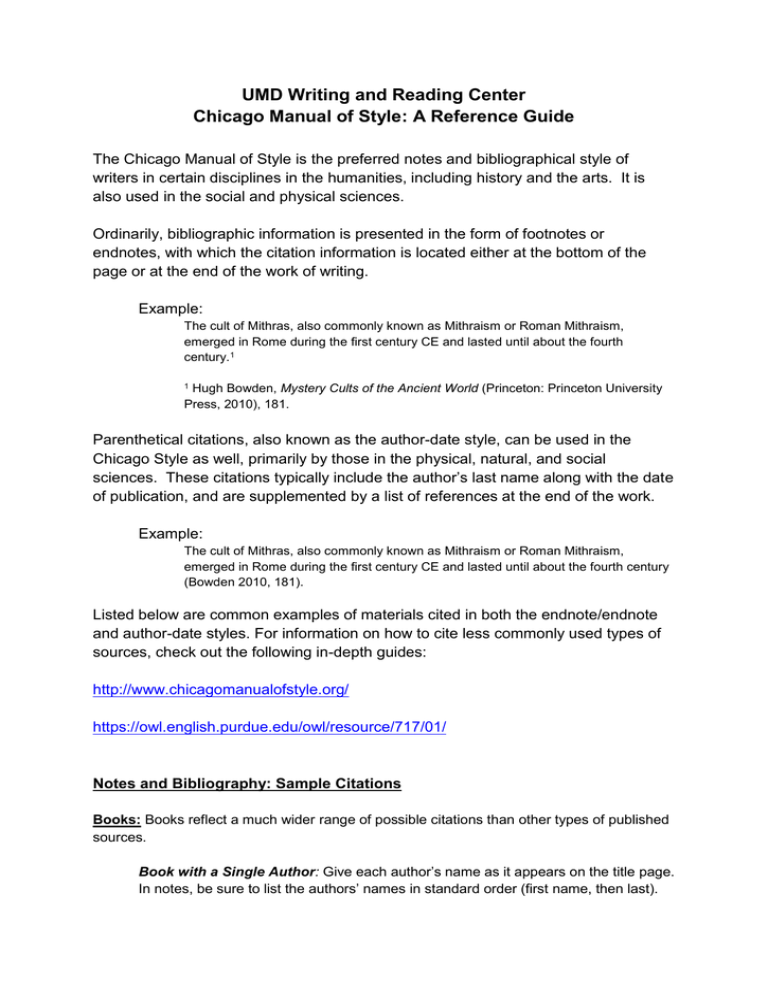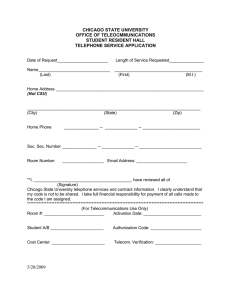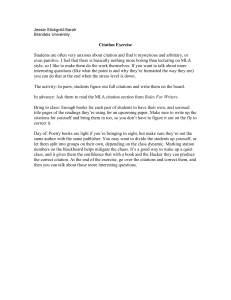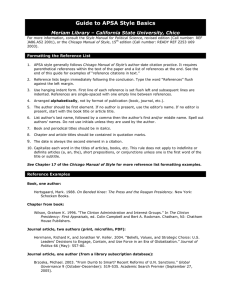UMD Writing and Reading Center
advertisement

UMD Writing and Reading Center Chicago Manual of Style: A Reference Guide The Chicago Manual of Style is the preferred notes and bibliographical style of writers in certain disciplines in the humanities, including history and the arts. It is also used in the social and physical sciences. Ordinarily, bibliographic information is presented in the form of footnotes or endnotes, with which the citation information is located either at the bottom of the page or at the end of the work of writing. Example: The cult of Mithras, also commonly known as Mithraism or Roman Mithraism, emerged in Rome during the first century CE and lasted until about the fourth century.1 1 Hugh Bowden, Mystery Cults of the Ancient World (Princeton: Princeton University Press, 2010), 181. Parenthetical citations, also known as the author-date style, can be used in the Chicago Style as well, primarily by those in the physical, natural, and social sciences. These citations typically include the author’s last name along with the date of publication, and are supplemented by a list of references at the end of the work. Example: The cult of Mithras, also commonly known as Mithraism or Roman Mithraism, emerged in Rome during the first century CE and lasted until about the fourth century (Bowden 2010, 181). Listed below are common examples of materials cited in both the endnote/endnote and author-date styles. For information on how to cite less commonly used types of sources, check out the following in-depth guides: http://www.chicagomanualofstyle.org/ https://owl.english.purdue.edu/owl/resource/717/01/ Notes and Bibliography: Sample Citations Books: Books reflect a much wider range of possible citations than other types of published sources. Book with a Single Author: Give each author’s name as it appears on the title page. In notes, be sure to list the authors’ names in standard order (first name, then last). 1 N: Philip Ball, Bright Earth: Art and the Invention of Color (New York: Farrar, Straus and Giroux, 2001), 140. 2 Dale Kent, The Rise of the Medici Faction in Florence: 1426-1434 (Oxford: Oxford University Press, 1978), 39. 3 Richard A. Goldthwaite, The Economy of Renaissance Florence (Baltimore: Johns Hopkins University Press, 2011), 77. For bibliographical entries, list the authors’ name in inverted order (last name first), while making sure that entries are listed in alphabetical order. B: Ball, Philip. Bright Earth: Art and the Invention of Color. New York: Farrar, Straus and Giroux, 2001. Goldthwaite, Richard A. The Economy of Renaissance Florence. Baltimore: Johns Hopkins University Press, 2011. Kent, Dale. The Rise of the Medici Faction in Florence: 1426-1434 (Oxford: Oxford University Press, 1978. Multiple Authors: If a work has multiple authors, list all names in standard order in the note. Use a comma before the and in a series of three or more. In the case of four or more authors, use only the first author’s name, followed by et al. 1 N: Kai Bird and Martin J. Sherwin, American Prometheus: The Triumph and Tragedy of J. Robert Oppenheimer (New York: Alfred A. Knopf, 2005), 52. 2 Joyce Appleby, Lynn Hunt, and Margaret Jacob, Telling the Truth about History (New York: W. W. Norton & Company, 1994), 135-56. 3 Jacquelyn Dowd Hall et al., Like a Family: The Making of a Southern Cotton Mill World (Chapel Hill: University of North Carolina Press, 1987), 11415. In the bibliographic entry, list the first author’s name in inverted order, and then list the rest of the authors in standard order. Do not use et al in a bibliography; list all of the authors. B: Appleby, Joyce, Lynn Hunt, and Margaret Jacob. Telling the Truth about History. New York: W. W. Norton & Company, 1994. Bird, Kai, and Martin J. Sherwin. American Prometheus: The Triumph and Tragedy of J. Robert Oppenheimer. New York: Alfred A. Knopf, 2005. Hall, Jacquelyn Dowd, James Leloudis, Robert Korstad, Mary Murphy, Lu Ann Jones, and Christopher B. Daly. Like a Family: The Making of a Southern Cotton Mill World. Chapel Hill: University of North Carolina Press, 1987. Work from an Anthology or Textbook: In the case where a cited source – a short story, a poem, an essay, or the like – comes from a collection of other published works, such as an anthology or a textbook, cite the author of the cited work followed by the anthology and its editor. In contrast to other works found in books, the title of anthological sources are enclosed in quotation marks; the only exception is the title of an excerpt from a book-length poem or prose work, which needs to be italicized. 1 N: Isabel Allende, "The Spirits Were Willing," in The Oxford Book of Latin American Essays, ed. Ilan Stavans (New York: Oxford University Press, 1997), 463-64. B: Wigglesworth, Michael. Excerpt from The Day of Doom. In The New Anthology of American Poetry: Traditions and Revolutions, Beginnings to 1900, edited by Steven Gould Axelrod, Camille Roman, and Thomas Travisano, 68-74. New Brunswick: Rutgers University Press, 2003. Edition: If you cite a book that has been published in more than one edition, always indicate which edition has been consulted, as each edition may have slight differences between one another. Always abbreviate wording such as Second Edition or Revised Edition to 2nd ed. or rev. ed. 1 N: Paul J. Bolt, Damon V. Coletta, and Collins G. Shackelford Jr., American Defense Policy, 8th ed. (Baltimore: Johns Hopkins University Press, 2005), 157-58. B: Babb, Florence. Between Field and Cooking Pot: The Political Economy of Marketwomen in Peru. Rev. ed. Austin: University of Texas Press, 1989. Daniels, Roger. Coming to America: A History of Immigration and Ethnicity in American Life. 2nd ed. New York: Harper Perennial, 2002. Volume: If a book is part of a multivolume work, be sure to include this in your citations. 1 N: Jaroslav Pelikan, Christian Doctrine and Modern Culture (Since 1700), vol. 5 of The Christian Tradition: A History of the Development of Doctrine (Chicago: University of Chicago Press, 1989), 16. B: Pelikan, Jaroslav. Christian Doctrine and Modern Culture (since 1700). Vol 5 of The Christian Tradition: A History of the Development of Doctrine. Chicago: University of Chicago Press, 1989. Journals: Many periodicals you will consult for a paper are classified as journals, which are scholarly or professional works accessible through academic libraries. Standard Format: List the complete article titles along with their subtitles. Make sure to enclose the title in quotation marks rather than italicizing. The title of the journal is italicized after the name of the article, followed by the volume number, the issue number (preceded by the abbreviation no.), the date of the article in parenthesis, and the page numbers. 1 N: Donald T. Dietrich, “National Renewal, Anti-Semitism, and Political Continuity: A Psychological Assessment,” Political Psychology 9, no. 3 (September 1988): 386. B: Dietrich, Donald T. “National Renewal, Anti-Semitism, and Political Continuity: A Psychological Assessment.” Political Psychology 9, no. 3 (September 1988): 385-411. Articles Published Online: For online journal entries, follow the same guidelines as listed above. At the end of the citation, be sure to list the URL and the date you accessed the material. 1 N: Brian Glyn Williams, “Shattering the Al Qaeda-Chechen Myth (Part II): Exploring Links Between the Chechen Resistance and Afghanistan,” Jamestown Foundation 4, no. 40 (November 6, 2003), http://www.brianglynwilliams.com/shattered_ll.pdf (accessed October 14, 2013). B: Williams, Brian Glyn. “Shattering the Al-Qaeda Myth (Part II): Exploring Links Between the Chechen Resistance and Afghanistan.” Jamestown Foundation 4, no. 40 (November 6, 2003). http://www.brianglynwilliams.com/shattered_ll.pdf (accessed October 14, 2013). Magazine Articles: Many of the guidelines for journal articles apply to magazine articles as well. Be sure to cite weekly or monthly magazines by date only, regardless of volume or issue. Also, do not enclose the date in parenthesis. 1 N: Mark Schapiro, “New Power for ‘Old Europe,’” The Nation, December 27, 2004, 12-13. B: Schapiro, Mark. “New Power for ‘Old Europe.’” The Nation, December 27, 2004. Newspaper Articles: Ordinarily, newspaper articles are cited only in notes. Unless an article is frequently used over the course of your paper, newspaper articles generally do not need to be included in your bibliography. The general pattern for magazine articles is followed in this case, but be sure to omit page numbers, as a newspaper may have several different editions in which items may appear on different pages, or may even be dropped altogether. If you cite an article by its headline, you can use either headline- or sentencestyle capitalization, so long as you remain consistent throughout. 1 N: Blair Kamin, “Wrigley Building Clearly a Landmark,” Chicago Tribune, July 1, 2005. or 1 Blair Kamin, “Wrigley Building clearly a landmark,” Chicago Tribune, July 1, 2005. Web Sites: Material that is posted online often lacks standard facts of publication, ie: author, title, publisher, or date. Regardless, it is still necessary to include information beyond the URL in your citations. When citing a web page, include as much of the following as possible: author, title of the page, owner of the site, URL, and access date. 1 N: Evanston Public Library of Trustees, “Evanston Public Library Strategic Plan, 2000-2010: A Decade of Outreach,” Evanston Public Library, http://www.epl.org/library/strategic-plan-00.html (accessed June 1, 2005). B: Evanston Public Library of Trustees. “Evanston Public Library Strategic Plan, 2000-2010: A Decade of Outreach.” Evanston Public Library. http://www.epl.org/library/strategic-plan-00.html (accessed June 1, 2005). If there is no named author, give the name of the owner of the site in its place. 1 N: Calvin College, “The German National Catechism,” http://www.calvin.edu/academic/cas/gpa/catech.htm (accessed May 7, 2012). B: Calvin College. “The German National Catechism.” http://www.calvin.edu/academic/cas/gpa/catech.htm (accessed May 7, 2012). Author-Date: Sample Citations Bibliographic citations change slightly while using the author-date style, but the main difference is the use of parenthetical citations versus footnotes or endnotes. The course of this section will exhibit the same situations as listed above. When listing the different forms of formatting, the bibliographic citation will be listed first, followed by the parenthetical citation. Books: When making the bibliographic citation in author-date style, the year of publication immediately follows the name of the author, rather than at the end of the citation. One Author R: Ball, Philip. 2001. Bright Earth: Art and the Invention of Color. New York: Farrar, Straus and Giroux. P: (Ball 2001, 140) Two or More Authors R: Bird, Kai, and Martin J. Sherwin. 2005. American Prometheus: The Triumph and Tragedy of J. Robert Oppenheimer. New York: Alfred A. Knopf. P: (Bird and Sherwin 2005, 52) For four or more authors, list only the first author in the parenthetical citation, followed by et al. R: Hall, Jacquelyn Dowd, James Leloudis, Robert Korstad, Mary Murphy, Lu Ann Jones, and Christopher B. Daly. 1987. Like a Family: The Making of a Southern Cotton Mill World. Chapel Hill: University of North Carolina Press. P: (Hall et al. 1987, 114-15). Anthologies: In contrast to the Notes and Bibliography style of formatting, the AuthorDate style does not use quotation marks enclosing the title of the work; it is instead just written in sentence-capitalization form with no italicization. R: Allende, Isabel. 1997. The spirits were willing. In The Oxford book of Latin American essays, ed. Ilan Stavans, 461-67. New York: Oxford University Press. P: (Allende 1997, 463-64) Editions R: Daniels, Roger. 2002. Coming to America: A history of immigration and ethnicity in American life. 2nd ed. New York: Harper Perennial. P: (Daniels 2002, 50) Volumes: In the case of the parenthetical citation, use the volume number before the page number. R: Pelikan, Jaroslav. 1989. Christian doctrine and modern culture (since 1700). Vol. 5 of The Christian tradition: A history of the development of doctrine. Chicago: University of Chicago Press. P: (Pelikan 1989, 5:83) Journals: Just as with books, the bibliographic citation remains largely the same as with the footnote style other than the year of publication immediately following the author. Regular Articles R: Dietrich, Donald T. 1988. “National Renewal, Anti-Semitism, and Political Continuity: A Psychological Assessment.” Political Psychology 9, no. 3 (September): 385-411. P: (Dietrich 1988, 385) Articles Published Online R: Williams, Brian Glyn. 2003. “Shattering the Al-Qaeda Myth (Part II): Exploring Links Between the Chechen Resistance and Afghanistan.” Jamestown Foundation 4, no. 40 (November 6). http://www.brianglynwilliams.com/shattered_ll.pdf (accessed October 14, 2013). P: (Williams 2003) Magazine Articles: Magazine articles follow many of the same general guidelines of journal articles. When writing the article titles, do not use quotation marks and use sentence style capitalization. R: Schapiro, Mark. 2004. New power for “Old Europe.” The Nation, December 27. P: (Schapiro 2004, 12-13) Newspaper Articles: Newspaper articles are cited in a similar manner to magazines. In the case of an unsigned article, use the name of the newspaper in place of the author. R: Kamin, Blair. 2005. Wrigley Building clearly a landmark. Chicago Tribune. July 1. P: (Kamin 2005) Web Sites: Web sites often lack standard facts of publication, such as the author, title, publisher, or date. When referencing a web site, be sure to include as much information as you can: the author, the title of the page, the owner of the site, the URL, and the access date. R: Evanston Public Library Board of Trustees. Evanston Public Library strategic plan, 2000-2010: A decade of outreach. Evanston Public Library. http://www.epl.org/library/strategic-plan-00.html (accessed June 1, 2005). P: (Evanston Public Library 2005) If no named author is given, give the name of the owner of the site. R: Federation of American Scientists. Resolution comparison: Reading license plates and headlines. http://www.fas.org/irp/imint/resolve5.html (accessed June 1, 2005). P: (Federation of American Scientists 2005) Resources Used Much of the above information was inspired by and excerpted and paraphrased from the following work: Turabian, Kate L. A Manual for Writers of Research Papers, Theses, and Dissertations: Chicago Style for Students and Researchers. 7th ed. Chicago: University of Chicago Press, 2007.





